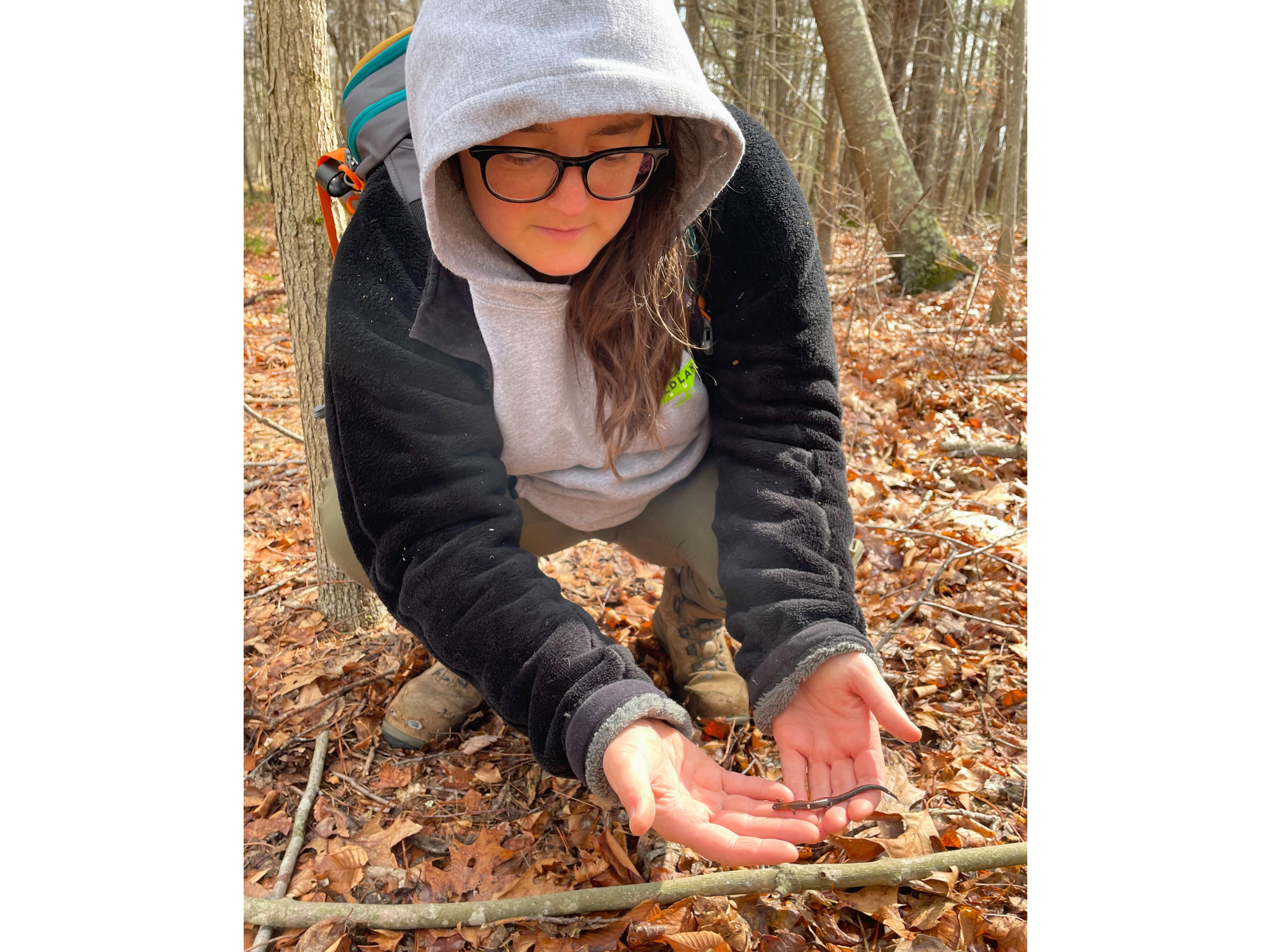What’s New at Wildlands
A VolunTuesday to Remember at Clark’s Island
By Marilynn Atterbury, Wildlands Trust board member & Key Volunteer
As a Wildlands Trust volunteer for over 11 years, I have seen many Wildlands preserves, many times over. So, you can imagine my excitement when I found out that on a special VolunTuesday in May, we would be venturing to a brand-new location, one that our fleet of pickup trucks couldn’t reach. On May 27, about 20 Wildlands staff and volunteers voyaged across Duxbury Bay to help the Duxbury Rural & Historical Society (DRHS) maintain its beautiful property on Clark’s Island.
Picture this: a beautiful Grady-White Boat with 300-horsepower twin engines flying across Duxbury Bay on a perfect May morning. The VolunTuesday crew was beyond excited for our adventure.
After wading through knee-deep water with chainsaws, loppers, and lunch in our arms, we proceeded to our mission for the day: removing invasive plant species from the meadow around Pulpit Rock, or what some consider the true Plymouth Rock!
DRHS owns 17 acres of land on Clark’s Island, which today is part of Plymouth. (Wildlands helps care for DRHS properties through our Community Stewardship Program.) In 1620, Mayflower passengers, led by first mate John Clark, made landfall on the island before they reached the Plymouth mainland. There, they found an enormous boulder and held their first worship service ashore.
The VolunTuesday crew at Pulpit Rock on Clark’s Island.
It’s important to acknowledge the darker side of history on Clark’s Island. During King Philip’s War (1675-1676), Plymouth Colony used the island as an internment camp to detain over 1,000 Indigenous people, many of whom starved to death. You can read a more detailed account of Clark’s Island history, along with a land acknowledgment, on the DRHS website.
Back to the present. It was a long, arduous VolunTuesday, interrupted only by a fantastic lunch on the lawn facing the Bay. We accomplished so much and learned so much about the history of Clark’s Island. Spirits were high as we motored back home. Everyone agreed it was one of the finest volunteer programs we had ever participated in.
***
Want to explore new places, join a fun-loving community, and give back to local nature? Explore upcoming VolunTuesday projects here!
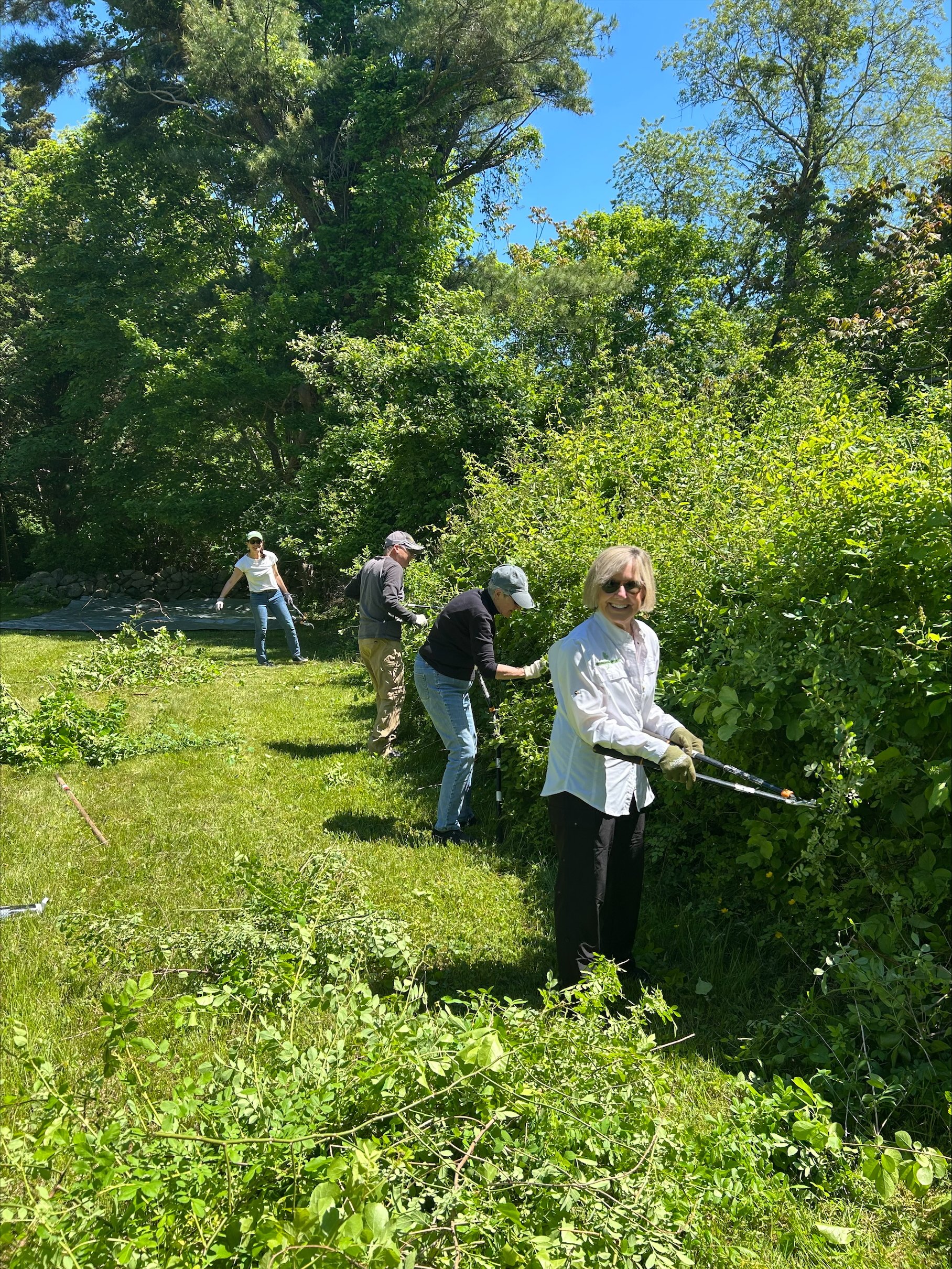
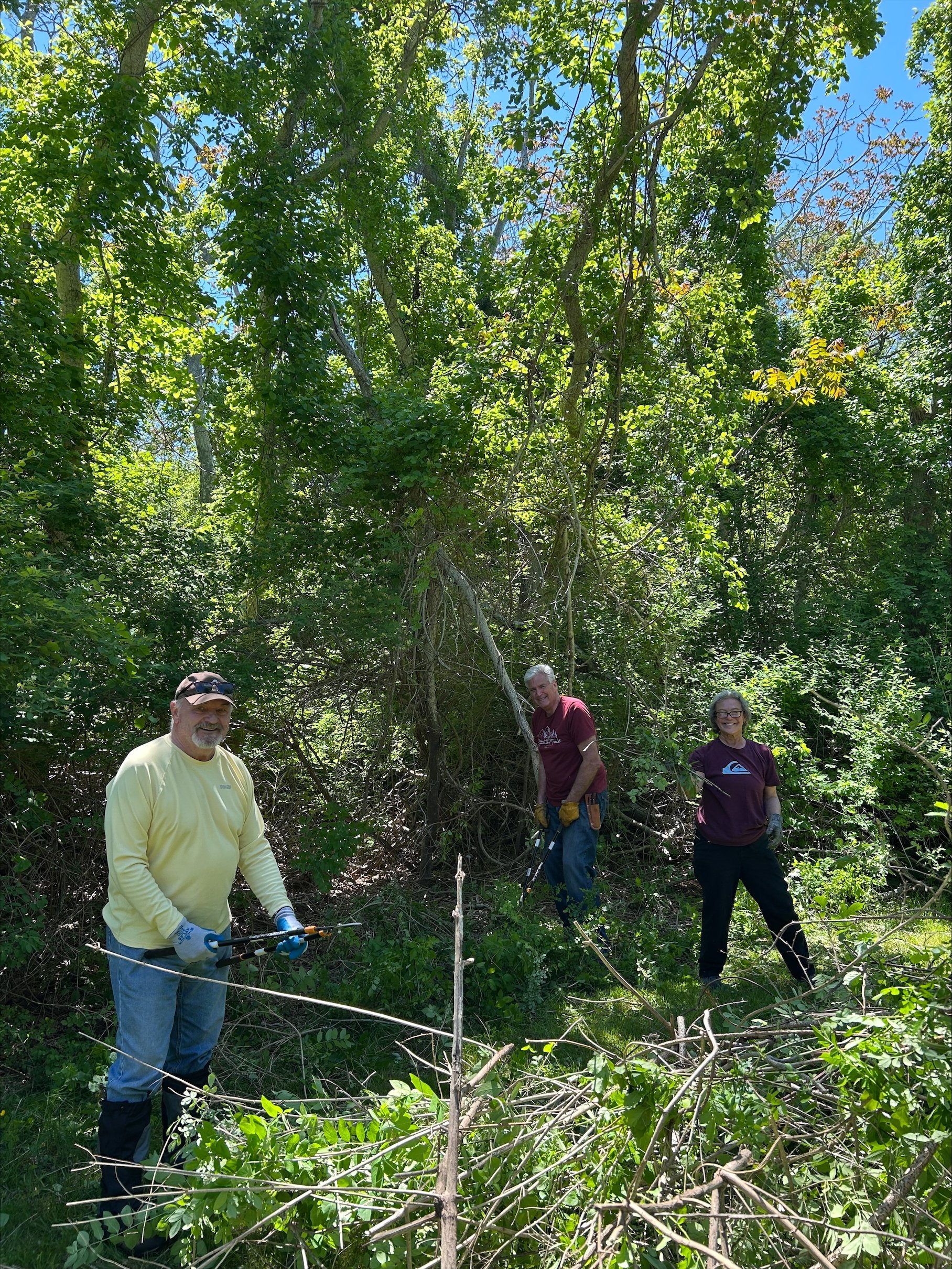

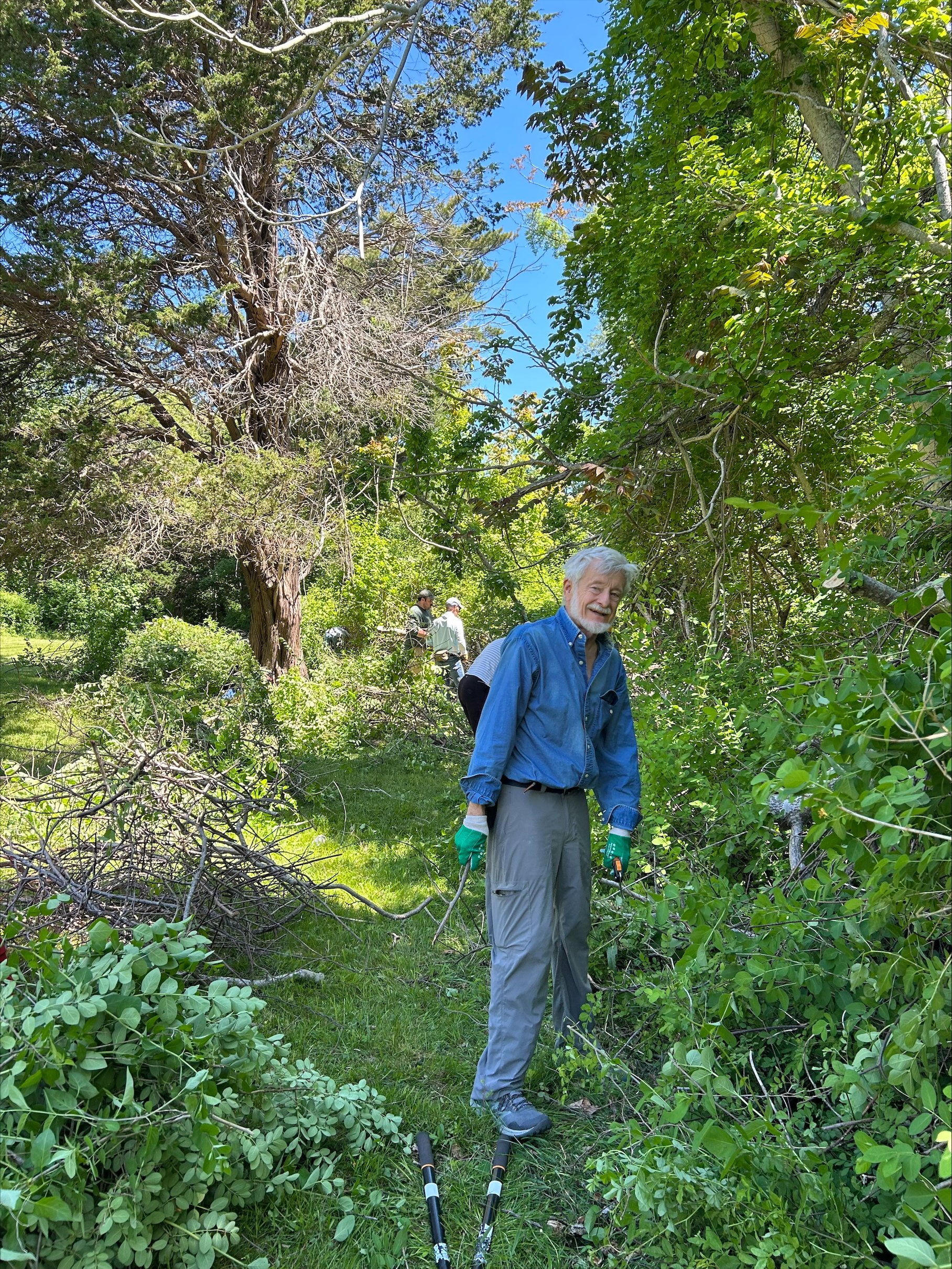


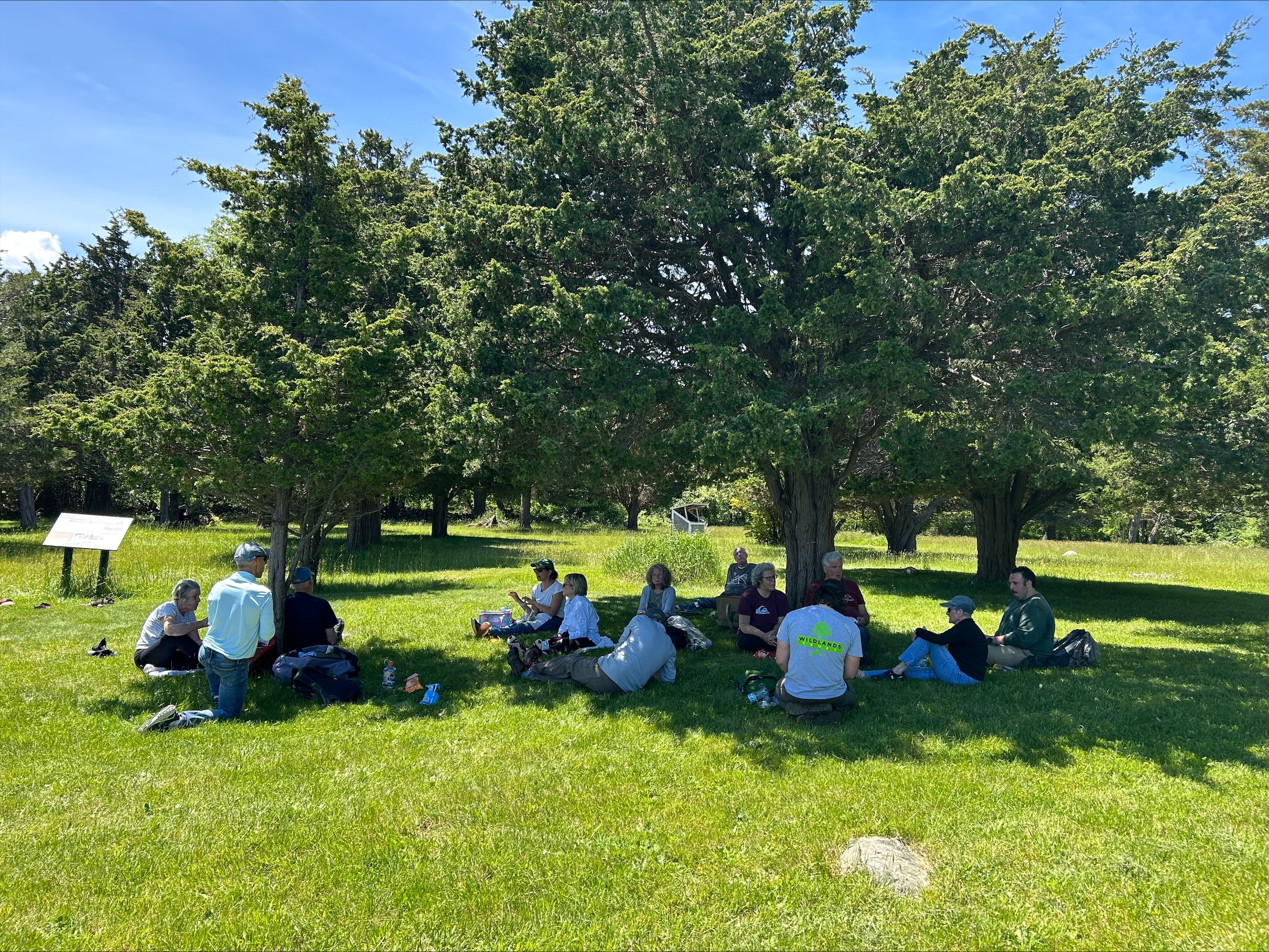
Vernal Pool Certification to Educate and Inspire
Stewardship Programs Manager Zoë Smiarowski handles a red-backed salamander at Striar Snake River Preserve in Taunton.
By Zoë Smiarowski, Stewardship Programs Manager
At Wildlands Trust, April 1 means one thing and one thing only: April Pools’ Day! In our book, protecting vernal pools is a more fun and fitting way to celebrate the arrival of spring in Southeastern Massachusetts than sitting on a whoopee cushion.
In observance of our favorite holiday, Wildlands staff and volunteers visited Striar Snake River Preserve to gather evidence of vernal pools on our 84-acre Taunton property. Vernal pools are one of the most delicate yet biodiverse ecosystems in our region, so Wildlands is working with the state to identify the ones we protect on our lands.
You may be wondering, what is a vernal pool? According to the Massachusetts Division of Fish & Wildlife’s Natural Heritage and Endangered Species Program (NHESP), “vernal pools are small, shallow ponds characterized by a lack of fish and annual or semi-annual periods of dryness. Vernal pool habitats are extremely important to a variety of wildlife species, including some amphibians that breed exclusively in vernal pools, and other organisms such as fairy shrimp which spend their entire life cycles confined to such locales.” Organisms that depend on vernal pools for at least part of their life cycle, such as wood frogs, spotted salamanders, and fairy shrimp, are called obligate species. Organisms that frequently use vernal pools but can survive in other habitats, such as spring peepers, gray treefrogs, and American toads, are called facultative species.
Wood frog egg mass discovered at Striar Snake River Preserve in Taunton.
Vernal pools occur widely across Massachusetts, wherever small depressions in the ground collect water in the spring. The important thing is no fish can enter the pool. Only when these predators are absent can certain frogs, salamanders, and invertebrates survive and reproduce there.
You can’t protect what you don't know is there. So, the state has mapped out where vernal pools might exist on the landscape. NHESP staff used aerial photographs between late March and early May of 1993, 1999, and 2000. Using stereo pairs (essentially two images, from slightly different angles, side by side), approximate centers of vernal pools were identified and then digitized onto the aerial photographs, creating a GIS data layer called “Potential Vernal Pools.” According to MassGIS, the data layer identifies more than 29,000 potential vernal pool habitats.
So how does a vernal pool go from potential to certified?
Potential vernal pools are based on aerial imagery alone. They must be ground-truthed to confirm a vernal pool community is actually present. With the right resources, anyone can submit data to help certify a vernal pool! MassWildlife provides guidelines for scientists, land managers, and community members alike to submit evidence for vernal pool certification. There are two certification methods: the obligate species method and the facultative species method. Since obligate species require vernal pools to breed, breeding evidence of these species, such as egg masses, larvae, or spring choruses, is a strong indication of a vernal pool. Evidence of facultative species is helpful, but not as definitive, so this method requires more information about the physical characteristics of the pool. As a result, the obligate species method is easiest for community scientists.
Vernal pool at Striar Snake River in Taunton.
Here’s how you can help certify a vernal pool:
Find potential vernal pools near you: explore the map here. Enter your address in the top search bar for local results.
Review the MassWildlife vernal pool certification guidelines.
Submit the necessary photo and video documentation to MassWildlife’s Heritage Hub.
All done! NHESP will notify you if your submission has been accepted for vernal pool certification.
As you can see, vernal pool certification is an involved process. You may be asking, what’s the point?
Certification can help protect vernal pools from human destruction or degradation. Some vernal pools are protected under the Massachusetts Wetlands Protection Act (WPA). That means that all proposed work that may alter these vernal pools must undergo a careful review by the local community’s conservation commission. Not all vernal pools fall under WPA jurisdiction, but several other state and local regulations extend protections to these sites, as well. Vernal pools must be certified by NHESP to trigger a review under any of these laws.
Stewardship Programs Manager Zoë Smiarowski wades in a vernal pool at Striar Snake River Preserve in Taunton in search for amphibian egg masses.
Given the somewhat complicated nature of the vernal pool certification process, what better way to learn the ins and outs than from the very organization that approves vernal pool certifications? In May of 2024, Wildlands teamed up with NHESP to lead a training at the Stewardship Training Center on vernal pool ecology, stewardship, and certification. Jacob Kubel, NHESP conservation scientist, and Matt Burne, a senior ecologist at the BSC group and Vice President of the Vernal Pool Association, led 15 land trust volunteers and staff in a seven-hour program, both in the classroom and out in the field. Attendees remarked on the excitement of discovering a salamander egg mass for the first time. I couldn’t help but agree. It's a magical, near-indescribable feeling!
Back at Striar Snake River Preserve on April 1, we found 77 egg masses of both wood frogs and spotted salamanders in pools throughout the property. (And that’s just the ones we were able to see, as we aimed to minimize disturbance in the center of the pools and focused when possible on what was visible from the shoreline.) Spotting and documenting amphibian egg masses feels like one of the most special experiences a person can have in the woods. Last year, Wildlands helped certify vernal pools on Duxbury Rural and Historical Society properties through a Community Stewardship contract. Even through some of the rainiest days of New England spring, the egg mass excitement carried us through!
Matt Penella, Town of Kingston Conservation Agent and Wildlands volunteer, searches for vernal pool evidence at Striar Snake River Preserve in Taunton.
Wildlands preserves are home to 10 certified vernal pools so far: five at Striar Conservancy in Halifax, four at Willow Brook Farm in Pembroke, and one at Brockton Audubon Preserve in Brockton. Dozens of potential vernal pools are located on Wildlands properties throughout Southeastern Massachusetts.
Previously, I mentioned that one of the strongest reasons for vernal pool certification is protection. So, what’s the use on properties that are already protected in perpetuity?
Indeed, vernal pools are safe and sound on Wildlands preserves. But certifying vernal pools on our properties gives our stewardship staff (and our supporters!) a better idea of the amazing natural resources we have the opportunity and responsibility to care for. Vernal pools are incredible features of our landscapes that support critical and unique habitat for some of our favorite little creatures. Spring peepers, wood frogs, spotted salamanders, and several other species rely on these habitats. We benefit from them, too, as they give us wonderful signs of spring. In springs to come, we hope to certify more vernal pools to teach our neighbors and supporters about their ecological importance and to help our community discover their otherworldly magic.
Welcome, Callahan!
Wildlands Trust is ecstatic to welcome Land Steward Callahan Coughlin to our team! Callahan is the second Land Steward to join us this winter, doubling the size of our permanent stewardship staff. Along with Rebecca Cushing, who joined us in January, Callahan will assist in the maintenance and management of Wildlands preserves. Read Callahan’s bio below, and be sure to say hello when you see him on the trails!
---
As a Wildlands Trust Land Steward, Callahan Coughlin returns to the region and organization that first set his sights on a career of community and impact.
Growing up near Plymouth’s Morton Park, Callahan spent much of his childhood in nature, wandering the woods with his siblings and kayaking on Billington Sea. He first encountered Wildlands in 2017 as a member of Green Team, our summer service-learning program for conservation-minded high school students. Even then, Callahan took note of the tight-knit dynamic of Wildlands’ staff. His time on Green Team led him to his first job at Bay End Farm in Bourne, which cemented his desire to work outdoors on a small, driven team. After college, Callahan spent six months in Georgia, conducting prescribed burns to restore the habitat of gopher tortoises and other native species. But the opportunity to monitor, maintain, and restore Wildlands’ protected areas, eight years after Green Team, compelled him to come home.
“I wanted to find something where I could make a real difference and learn more about local plants and wildlife,” Callahan said. “It’s inspiring to do good work with good people.”
Callahan studied environmental science and agriculture at UMass Amherst. After graduating, he completed an internship with the Friends of Chatham Waterways. In his free time, Callahan enjoys kayaking, archery, cooking, and identifying flora and fauna. He also serves as a Marine Animal Rescue & Response Volunteer for Whale and Dolphin Conservation.
Trail Updates: Willow Brook Farm & Beyond
Harry and Mary Todd Trail at Willow Brook Farm in Pembroke. Photo by Rob MacDonald.
It’s been almost a year since we started our revitalization project at Willow Brook Farm in Pembroke. Thanks to your support of our summer fundraising campaign, we’ve already made major strides toward our goal of keeping Willow Brook healthy and safe for future generations of people and wildlife. While there’s much left to do, we wanted to keep you apprised of the latest on our efforts.
In early February, Wildlands staff and volunteers spent a VolunTuesday completing the replacement of the first boardwalk on the Harry and Mary Todd Trail. That means, after a couple months out of service, the Todd Trail is back open! The trail will close again at some point in the spring so our stewardship team can repair the second boardwalk. So enjoy it while you can!
Earlier this winter, we also cleared a new trail along the perimeter of Willow Brook’s central field. Known as the Pasture Loop, the path affords visitors a close-up view of the freshly restored stone wall, and a glimpse into the preserve’s agricultural past. Learn more about the human history of Willow Brook Farm here.
Pasture Loop at Willow Brook Farm in Pembroke. Photo by Rob MacDonald.
If it’s been a while since you’ve visited Willow Brook Farm, you’ll notice an even more dramatic change to the landscape, with trees and other vegetation cleared back from much of the entrance trail and field. That’s because Wildlands has embarked on an ambitious restoration of the preserve’s grassland habitat.
True to its name, Willow Brook Farm was an agricultural site for over 300 years. Diverse wildlife made itself home in the grasslands spanning most of the property. Since then, forests have reclaimed much of the land, save for the central field that Wildlands mows annually to preserve this critical habitat. Unfortunately, invasive plants and woody growth continue to encroach on the field from the forest edges, threatening the grassland’s suitability for native birds, insects, and other wildlife. Removing this aggressive vegetation is the first step to restoring the field’s beauty and diversity.
Grassland restoration is a multi-year process, so we appreciate your patience.
Willow Brook Farm in Pembroke. Photo by Rob MacDonald.
Up next at Willow Brook Farm: refurbishing the parking lot, improving trail signage, and building covered picnic tables. Stay tuned!
In other trails news:
Thanks to our VolunTuesday crew, a new trail at Emery Preserve in Plymouth offers visitors a more varied route to the iconic Beech Tree Clearing. The trail is now a loop, connecting to existing trails on the other side of Ship Pond Road.
See the green loop in the southeast corner of this trail map:
At Sylvester Field Conservation Area in Hanover, the boardwalk on the southeast portion of the trail loop is closed for the winter as Wildlands staff works to lower its incline. The rest of the trail remains open.
See you on the trails!
Welcome, Rebecca!
Wildlands kicked off 2025 with a new addition to our team! Join us in welcoming Rebecca Cushing (she/her), one of two full-time Land Stewards coming aboard this winter. (Stay tuned for the introduction of our second Land Steward, set to start in February!) Get to know Rebecca in the bio below, and be sure to say hello when you see her on the trails!
---
What do art education and land stewardship have in common? More than you might think, as evidenced by Rebecca Cushing’s full-circle journey to Wildlands Trust.
Raised in Plymouth by parents from inner-city Boston, Rebecca grew up with a “casual” love for nature. It was a different passion she pursued in college, studying art, secondary education, and art history at Bridgewater State University. After graduating, Rebecca moved to Georgia, where she taught elementary school art for one-and-a-half years. But the stunning salt marshes and ancient live oaks of the Georgia coast had other plans for Rebecca, capturing her heart and sending her down an exciting (albeit hotter and buggier) new path. Rebecca returned to school, earning a second bachelor’s degree in biology with a concentration in coastal ecology and minor in environmental science from the College of Coastal Georgia. Equipped with new ecological knowledge and skills, Rebecca joined St. Simons Land Trust in 2022 as a land steward technician. Her background in art and education came into play early and often.
“As a creative person, you rely on your skills of observation,” Rebecca said. “You have to slow down, pay attention to details, be curious about what’s around you, and share that appreciation with others. It’s the same in conservation, when you’re trying to empower communities to take care of their natural lands.”
Rebecca joined Wildlands in early 2025 to apply what she has learned to the ecosystems that backdropped her youth. As a Land Steward, she spends most of her time outdoors, monitoring and maintaining Wildlands’ protected areas. Rebecca is excited to serve people as much as nature, promoting public access, volunteerism, and education so future generations can have trails, views, and wildlife to enjoy. She moved back to Plymouth to be close to her family, including her young nieces and nephew. In addition to exploring local preserves with these budding naturalists, Rebecca enjoys hiking, biking, kayaking, and running. She also continues her artistic practice of block printing and painting, always inspired by the natural world. View her amazing work here.






